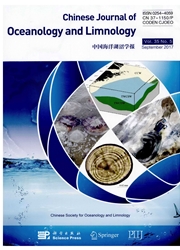

 中文摘要:
中文摘要:
夏眠,冬眠,和饥饿是在自然并且在文化池溏里的海黄瓜 Apostichopus japonicus 的不可缺少的不活跃的状态。通常,温度是在海黄瓜导致夏眠或冬眠的主要因素。现在的学习提供了卓见进 A 的生理的改编。japonicus 在由在实验室下面测量氧消费率(Vo2 ) 和生物化学的作文的迟钝(冬眠,夏眠,和饥饿) 的三种类型期间调节低(3 掳 C ) ,正常(17 掳 C ) 和高度(24 掳 C ) 温度。结果出现 A 的特征。在休眠(冬眠和夏眠) 的 japonicus 说与高级动物相当不同,例如鱼,两栖动物,爬行动物,和哺乳动物,但是更非常类似于一个半休眠的状态。它被观察在 A 的移动。japonicus 到休眠的从正常的生理的状态是一个长期而非尖锐的过程,由新陈代谢的率的渐渐的消沉显示了。当新陈代谢的率衰退了时, 44.9% 为夏眠组织, 71.7% 为冬眠组织,在 36 d 文化时期期间,相对起始的率,新陈代谢的率没在这些状态期间在经常的层次被维持。为在冬眠和夏眠的海黄瓜的新陈代谢的消沉过程看起来是一被动并且活跃新陈代谢的抑制分别地。相反,新陈代谢的率( 128.90 卤1 1.70 渭g /g h ) estivating ,海黄瓜是尤其是更高的( 107.85 卤6 .31 渭g /g h )与比在在 17 掳C ,它显示了使海黄瓜饿这里的休眠机制作为生理的抑制,不象在高级动物一样有效。最后,原则在冬眠的海黄瓜的新陈代谢的底层或精力来源是类脂化合物,而在夏眠他们主要此后在早时间和蛋白质和类脂化合物消费了蛋白质。关键词 Apostichopus japonicus - 氧消费率 - 化学作文 - 温度,中国(No.30400333 ) 和国家钥匙的国家自然科学基础支持的迟钝的时期中国(2006BAD09A01 ) 的科技编程序
 英文摘要:
英文摘要:
Estivation, hibernation, and starvation are indispensable inactive states of sea cucumbers Apostichopusjaponicus in nature and in culture ponds. Generally, temperature is the principal factor that induces estivation or hibernation in the sea cucumber. The present study provided insight into the physiological adaptations ofA. japonicus during the three types of inactivity (hibernation, estivation, and starvation) by measuring the oxygen consumption rates (Vo2) and biochemical compositions under laboratory conditions of low (3℃), normal (17℃) and high (24℃) temperature. The results show that the characteristics of A. japonicus in dormancy (hibernation and estivation) states were quite different from higher animals, such as fishes, amphibians, reptiles, and mammals, but more closely resembled a semi-dormant state. It was observed that the shift in the A. japonicus physiological state from normal to dormancy was a chronic rather than acute process, indicated by the gradual depression of metabolic rate. While metabolic rates declined 44.9% for the estivation group and 71.7% for the hibernation group, relative to initial rates, during the 36 d culture period, metabolic rates were not maintained at constant levels during these states. The metabolic depression processes for sea cucumbers in hibernation and estivation appeared to be a passive and an active metabolic suppression, respectively. In contrast, the metabolic rates (128.904-11.70 μg/g h) of estivating sea cucumbers were notably higher (107.85±6.31 μg/gh) than in starving sea cucumbers at 17℃, which indicated that the dormancy mechanism here, as a physiological inhibition, was not as efficient as in higher animals. Finally, the principle metabolic substrate or energy source of sea cucumbers in hibernation was lipid, whereas in estivation they mainly consumed protein in the early times and both protein and lipid thereafter.
 同期刊论文项目
同期刊论文项目
 同项目期刊论文
同项目期刊论文
 期刊信息
期刊信息
